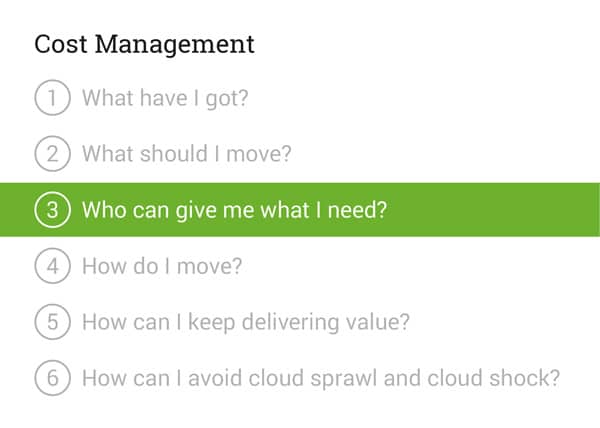Planning Your Cloud Move: “Who Can Give Me What I Need?”
-
February 14, 2019
- Posted by: Simon Croyden

If you’ve been following the advice offered in this blog series so far, you’ll have built up an accurate picture of your as-is IT estate, amended it to exploit any opportunities for rationalization, and pinpointed any applications that need to remain on-premise. Armed with this clear statement of your requirements, you’re now in a position to start approaching and evaluating cloud vendors to see which one can best satisfy your needs.

Checklist for Evaluating Cloud Vendors
First, though, it’s important to be clear about some basic differences between providers. Some will match your usage profile better than others, which may point you in one direction rather than another. You may find that vendors – including the three main vendors, Amazon Web Services, Google Cloud, and Microsoft Azure – differ in particulars such as:
- Ease of use. Evaluate any tools available to help with the migration process, as well as those that help you monitor and manage use once you’ve migrated.
- Geographical presence. This can be especially important if you need or prefer to store data in a specific region, perhaps for information security reasons.
- Pricing basis. On-demand pricing is by the hour or by the minute – but there are also variations where you commit to certain levels of usage in return for a lower fee.
- Market share. While the major vendors all have a sound footing in the market, it may be worth finding out who has the largest share in your business sector, and any reasons for the preference (for example, differences in security provision may be critical in the public sector and financial services).
- Tools available for management and monitoring. As well as day-to-day running, these should help you address security and compliance requirements. How do the tools on offer compare with what you currently have on-premise?
- Ease of integration with standard office software. Your organization’s choice of software may nudge you in a particular direction but this consideration shouldn’t carry undue weight as any cloud platform should be compatible with any standard product.
While evaluating cloud vendors, you should talk to those that seem best suited to your needs and experiment with each vendor’s offering to test whether it will actually provide what you expect. Try different configurations on each cloud platform and compare the performance you get on each one with your as-is metrics to ensure you are getting the performance you need at the right price.